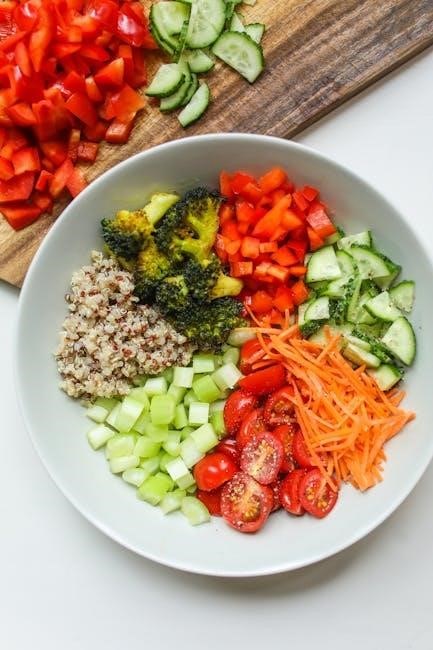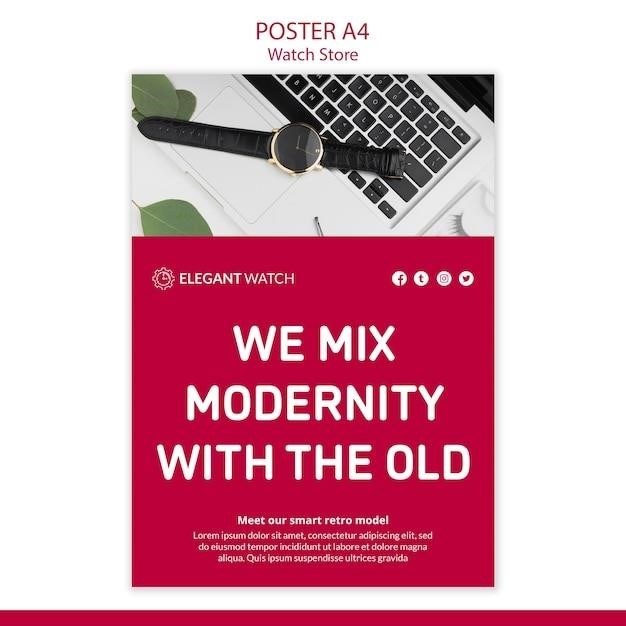hyperparathyroidism diet pdf
Hyperparathyroidism Diet: An Overview
While there’s no one-size-fits-all “hyperparathyroidism diet‚” general nutritional guidelines emphasize balanced calcium intake and regular meals to maintain stable calcium levels․ Individual needs vary‚ and medical intervention is often the primary treatment․

Understanding Hyperparathyroidism
Hyperparathyroidism involves the overactivity of the parathyroid glands‚ leading to elevated calcium levels in the blood․ It’s often managed medically‚ and dietary considerations play a supporting role․
Primary vs․ Secondary Hyperparathyroidism
Primary hyperparathyroidism stems from an issue within the parathyroid glands themselves‚ often due to a benign tumor․ This leads to an overproduction of parathyroid hormone (PTH)‚ subsequently causing elevated calcium levels in the blood․ Dietary calcium restriction was once common advice‚ but current guidelines suggest avoiding excessive restriction‚ especially for those with low dietary calcium intake․ Medical options and surgery are often considered․
Secondary hyperparathyroidism‚ conversely‚ arises as a result of another underlying condition․ This is frequently chronic kidney disease‚ where the kidneys’ inability to properly process vitamin D leads to low calcium levels․ In response‚ the parathyroid glands become overactive to compensate․ Dietary management in secondary hyperparathyroidism focuses on addressing the underlying condition‚ often involving phosphate control and vitamin D supplementation․ Therefore‚ understanding the distinction is crucial for appropriate management․

General Dietary Guidelines for Hyperparathyroidism
General dietary guidelines involve maintaining balanced calcium intake‚ avoiding excessive restriction‚ and eating regular meals․ These strategies help stabilize calcium levels․ Always seek personalized advice from professionals․
Importance of Balanced Calcium Intake
Maintaining a balanced calcium intake is crucial for individuals with hyperparathyroidism․ Contrary to previous beliefs‚ restricting calcium is not always recommended‚ especially for those with primary hyperparathyroidism (PHPT)․ Current guidelines suggest that individuals with PHPT should not excessively limit dietary calcium‚ but rather aim for the recommended daily limits․
Balanced calcium intake helps to prevent drastic fluctuations in calcium levels․ Regular meals with adequate calcium content contribute to stable levels‚ avoiding situations where levels drop significantly‚ potentially triggering further parathyroid hormone release․ However‚ it’s essential not to exceed the recommended daily intake․
The key is finding a middle ground that supports overall bone health without exacerbating hypercalcemia․ Consulting with a healthcare professional or registered dietitian is vital to determine the appropriate calcium intake based on individual needs and the specific type of hyperparathyroidism․
Recommended Daily Calcium Intake
The recommended daily calcium intake varies depending on age and sex․ For adults aged 19 to 50 and men aged 51 to 70‚ the general recommendation is 1‚000 milligrams (mg) of calcium per day․ This recommendation increases to 1‚200 mg per day for women aged 51 and older and men aged 71 and older․ These guidelines are based on recommendations from the Institute of Medicine․
However‚ individuals with hyperparathyroidism should consult their healthcare provider to determine their specific calcium needs․ While restricting calcium is not generally advised‚ exceeding the recommended daily limits is also not beneficial․ Individual nutrient needs are patient-dependent‚ and a healthcare professional can provide personalized guidance․
It’s important to consider both dietary sources and potential supplementation when assessing daily calcium intake․ Aim to obtain calcium primarily through food‚ and use supplements only as directed by a healthcare provider․

Foods to Include in a Hyperparathyroidism Diet
Focus on calcium-rich foods like beans‚ almonds‚ and dark green leafy vegetables such as spinach and kale․ Ensure adequate vitamin D intake to aid calcium absorption․
Calcium-Rich Foods: Sources and Benefits
Incorporating calcium-rich foods into your diet is crucial‚ but it’s essential to understand their role in managing hyperparathyroidism․ Sources include dairy alternatives like almond milk‚ leafy greens such as kale and spinach‚ beans‚ and fortified foods․ These foods contribute to overall bone health and help maintain stable calcium levels․
However‚ it’s important to remember that individuals with primary hyperparathyroidism should not drastically restrict calcium intake unless specifically advised by their doctor․ The focus should be on meeting the recommended daily allowance‚ not exceeding it․
The benefits of consuming adequate calcium extend beyond bone health․ Calcium plays a role in muscle function‚ nerve transmission‚ and hormone secretion․ By choosing calcium-rich foods‚ you’re supporting these vital bodily functions while also addressing the potential calcium imbalances associated with hyperparathyroidism․
Examples of Calcium-Rich Foods

To effectively manage hyperparathyroidism through diet‚ it’s essential to know specific examples of calcium-rich foods․ Dairy products‚ such as milk‚ yogurt‚ and cheese‚ are well-known sources‚ although alternatives like almond milk‚ and calcium-set tofu‚ are also good choices․ Leafy green vegetables‚ including kale‚ collard greens‚ and spinach‚ contribute significantly․
Other notable examples include beans‚ almonds‚ and fortified foods‚ such as certain cereals and orange juice․ When selecting fortified foods‚ check the nutrition label to ensure they provide a substantial amount of calcium․
Remember to consume these foods as part of a balanced diet‚ alongside other essential nutrients․ While calcium is vital‚ it’s crucial to avoid excessive intake‚ as this could potentially worsen hyperparathyroidism symptoms․ Consulting a dietitian or healthcare professional can help tailor your diet to your specific needs․
Vitamin D Intake and its Role
Vitamin D plays a crucial role in calcium absorption‚ making it an important consideration in managing hyperparathyroidism․ Adequate vitamin D levels help the body utilize calcium effectively‚ supporting bone health and overall well-being․ The recommended daily intake of vitamin D is 600 IU for adults‚ but individual needs may vary․
Sunlight exposure is a natural source of vitamin D‚ but many individuals may not get enough through this method alone‚ especially during winter months or with limited outdoor activity․ Dietary sources include fatty fish like salmon and tuna‚ egg yolks‚ and fortified foods such as milk and cereals․
Supplementation may be necessary to achieve optimal vitamin D levels․ It’s essential to consult a healthcare professional to determine the appropriate dosage‚ as excessive vitamin D intake can also have adverse effects․ Maintaining a balance is key․

Foods to Avoid or Limit
While not always necessary‚ some advise limiting refined foods․ Some also suggest removing potential food allergens like dairy‚ wheat and soy․ A diet low in phosphates is sometimes suggested․
Refined Foods and Their Impact
Refined foods‚ such as white bread‚ pasta‚ and sugary cereals‚ are often discouraged in dietary recommendations for hyperparathyroidism․ This is because these foods can lack essential nutrients and may contribute to imbalances in the body that could potentially affect calcium regulation․
While not a direct cause of hyperparathyroidism‚ refined foods can contribute to overall inflammation and nutritional deficiencies․ Choosing whole‚ unprocessed foods provides a broader range of vitamins and minerals that support overall health․ Some believe that minimizing refined foods can support the body’s natural processes․
It is important to note that the impact of refined foods on hyperparathyroidism is not definitively proven‚ and more research is needed․ However‚ adopting a diet rich in whole foods and low in refined products is generally recommended for overall health and well-being․ Always consult with a healthcare professional for personalized dietary advice․
Potential Food Allergens
Identifying and managing potential food allergens is sometimes considered within the context of hyperparathyroidism‚ though their direct impact on the condition is not fully established․ Some practitioners suggest eliminating common allergens‚ such as dairy‚ wheat (gluten)‚ soy‚ and corn‚ to reduce potential inflammation or immune responses that may indirectly affect calcium balance․

The rationale behind this approach is that food allergies or sensitivities can trigger systemic inflammation‚ which might influence various bodily functions․ However‚ it’s crucial to note that this is not a standard recommendation for hyperparathyroidism‚ and there’s limited scientific evidence to support it․
Before making significant dietary changes‚ especially eliminating entire food groups‚ it’s essential to consult with a healthcare professional or registered dietitian․ They can help determine if food allergies or sensitivities are a concern and guide you through appropriate testing and dietary modifications while ensuring you maintain adequate nutrient intake․ Self-diagnosis and elimination diets can lead to nutritional deficiencies if not properly managed․
Foods High in Phosphate
While dietary calcium often takes center stage in discussions about hyperparathyroidism‚ managing phosphate intake can also be relevant‚ particularly in secondary hyperparathyroidism․ High phosphate levels can stimulate the parathyroid glands‚ potentially exacerbating the condition․ Therefore‚ being mindful of foods high in phosphate is sometimes recommended․
Foods rich in phosphate include dairy products‚ processed foods‚ red meat‚ organ meats‚ and certain beverages like dark colas․ Legumes and nuts also contain phosphate‚ but they are generally part of a healthy diet and should not be restricted without professional guidance․
For individuals with secondary hyperparathyroidism‚ especially those with kidney disease‚ limiting phosphate intake may be beneficial․ However‚ it’s crucial to work with a registered dietitian or healthcare provider to determine the appropriate level of restriction․ Drastically reducing phosphate without proper guidance can lead to nutrient imbalances and other health problems․ The focus should be on a balanced diet that supports overall health while addressing the specific needs related to hyperparathyroidism․

Meal Planning and Regular Eating Habits
Consistent meal times‚ including calcium-rich foods‚ aid in stabilizing calcium levels․ Avoid skipping meals or prolonged periods without eating‚ as this can cause calcium fluctuations․
Importance of Regular Meals
Maintaining regular eating habits plays a crucial role in managing hyperparathyroidism‚ primarily by promoting stable calcium levels․ Consistent meal timing helps to avoid drastic fluctuations in serum calcium‚ which can exacerbate symptoms or interfere with treatment․ Regular meals with a good calcium content help keep calcium levels stable․
Skipping meals or allowing long gaps between eating can lead to periods of low calcium‚ potentially triggering the parathyroid glands to release more parathyroid hormone (PTH) in an attempt to raise calcium levels․ This can perpetuate the hyperparathyroid state․
Furthermore‚ consistent eating patterns support overall metabolic health and can enhance the effectiveness of any medical interventions․ A balanced approach to nutrition‚ distributed throughout the day‚ ensures a steady supply of nutrients and minimizes stress on the body’s regulatory systems․ Regular meals are a foundational aspect of dietary management․
Avoiding Long Gaps Between Meals
Prolonged periods without food can significantly impact calcium regulation in individuals with hyperparathyroidism․ When the body goes without sustenance for extended durations‚ blood sugar levels drop‚ triggering hormonal responses aimed at maintaining homeostasis․ One of these responses can involve the parathyroid glands․
In an attempt to compensate for falling calcium levels‚ the parathyroid glands may release more parathyroid hormone (PTH)․ This surge in PTH can further exacerbate the underlying hyperparathyroid condition‚ potentially leading to increased bone resorption and elevated serum calcium․
Therefore‚ it is crucial for individuals with hyperparathyroidism to avoid long intervals between meals․ Snacking between meals‚ if necessary‚ is an effective way to keep calcium levels stable․ Consuming small‚ frequent meals throughout the day helps to minimize fluctuations in calcium and reduces the burden on the parathyroid glands․ This proactive approach supports overall metabolic stability and promotes better management of the condition․

When to Seek Professional Advice
Consulting a healthcare professional‚ such as a doctor or registered dietitian‚ is essential for personalized guidance on managing hyperparathyroidism․ They can provide tailored dietary recommendations based on your individual needs․
Consulting a Doctor or Dietitian
Seeking professional advice from a doctor or registered dietitian is crucial when managing hyperparathyroidism․ While general dietary guidelines exist‚ individual needs vary significantly․ A healthcare professional can assess your specific condition‚ taking into account factors such as the type of hyperparathyroidism (primary or secondary)‚ the severity of the condition‚ any underlying health issues‚ and your current dietary habits․
A doctor can accurately diagnose the condition‚ determine the underlying cause‚ and recommend the most appropriate treatment plan‚ which may include medication or surgery․ A registered dietitian can provide personalized dietary recommendations tailored to your specific needs and treatment plan․ They can help you optimize your calcium and phosphate intake‚ identify potential food allergens‚ and develop a meal plan that supports your overall health and well-being․ Furthermore‚ they can monitor your progress and make adjustments to your diet as needed․ Remember‚ self-treating hyperparathyroidism can be dangerous‚ so professional guidance is essential․

Medical Options and Diet
Medical interventions‚ such as medication or surgery (parathyroidectomy)‚ are often the primary treatment for hyperparathyroidism․ However‚ dietary adjustments can play a supportive role‚ especially when managing symptoms and preventing complications․ For individuals who choose not to undergo surgery or meet specific medical guidelines‚ medical options are available‚ and diet becomes even more critical․
While a specific diet isn’t a standalone treatment‚ it can complement medical interventions․ For instance‚ maintaining adequate hydration and avoiding excessive calcium restriction (unless specifically advised by a doctor) are often recommended․ Working closely with a healthcare professional to monitor calcium levels and adjust dietary intake based on individual needs is essential․ Moreover‚ a balanced diet rich in essential nutrients can support overall health and well-being during medical treatment‚ potentially improving outcomes and quality of life․ The interplay between medical options and dietary considerations should be carefully managed under professional guidance․














